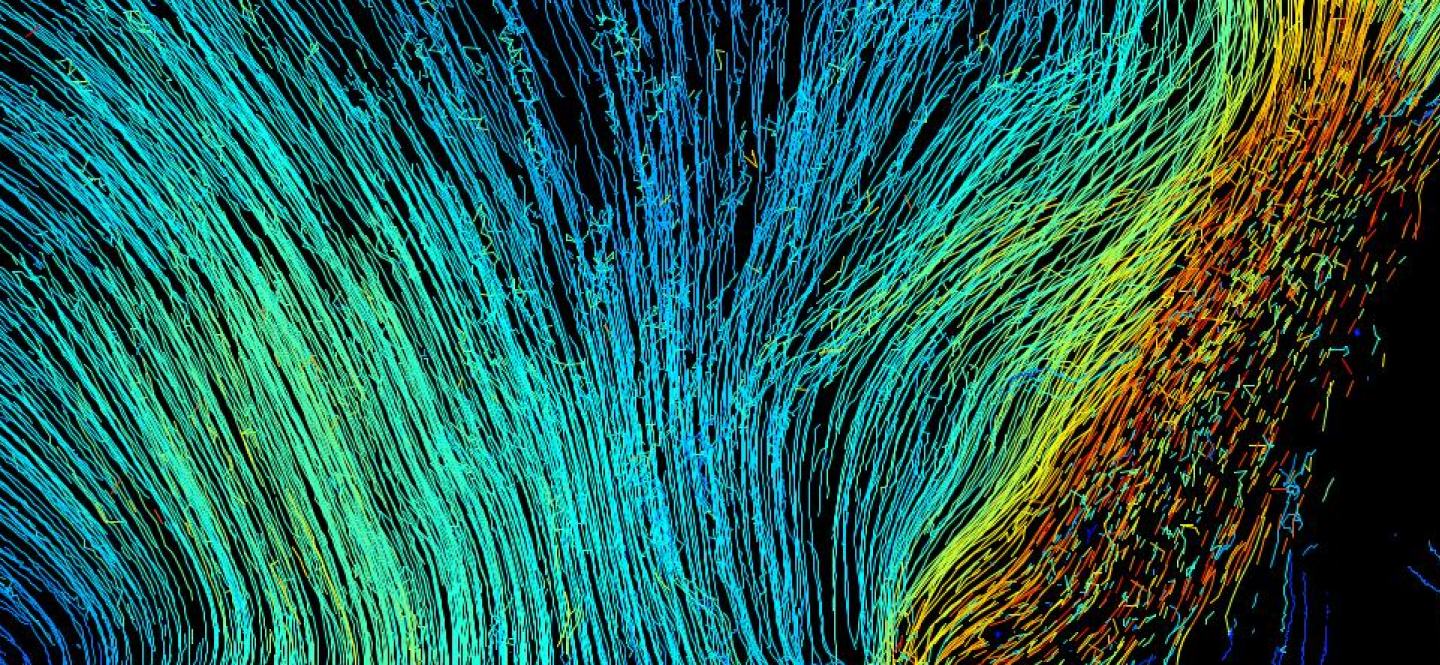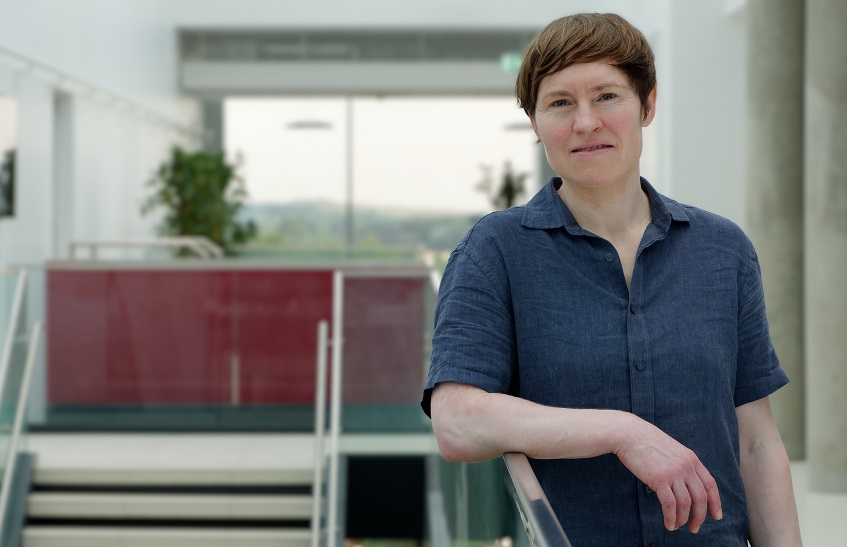New perspective on neurodegenerative diseases
#Pioneer projects
Dr. Giancarlo Porcella, Helmholtz Munich
Images of cilia-induced flow in brain ventricles. The colours represent the speed of the flow.
Biophysicist Janna Nawroth wants to find out how cilia in our brain ventricles influence the development of neuronal diseases and certain neurological conditions such as sleep. A "pioneer project".
Your most recent research project is dedicated to cilia. Can you explain what cilia are and what role they play in our body?
Dr. Janna Nawroth: These hair-like structures on the surface of cells move rhythmically to transport fluids. They are found in many organisms, from single-celled organisms to complex creatures like us humans. In the human organism, they can be found in various places in the body: for example in the respiratory tract, where they transport mucus, germs, and foreign bodies out of the lungs. Their role in the cerebral ventricles, the fluid-filled cavities of our brain, is particularly exciting.
What are they doing there?
They ensure that the cerebrospinal fluid remains in motion. This in turn is important as thermal protection or for the metabolism of the nerve cells in the brain and spinal cord.
How did you come up with your research? Before you, hardly anyone had investigated the cilia in the human brain.
I actually carried out my first research on marine organisms such as squid, jellyfish, and deep-sea tadpoles. They use cilia to move in the water or transport food. Later, I researched the cilia on the respiratory tract. The interesting thing is that cilia function very similarly in paramecia and humans! The mechanism by which cilia beat and move liquids has been preserved almost unchanged over the course of evolution.

Biophysicist Dr. Janna Nawroth is Principal Investigator at the Helmholtz Pioneer Campus - Bioengineering.
And yet they fulfil different tasks.
Correct. In marine animals they mostly move water: in mammals the function depends on the tissue in question. So, after researching marine organisms, it was a natural step for me to consider the role these structures play in humans – especially in organs that we don't yet know much about, such as the brain?
How did you realise the importance of cilia for the human brain?
We now know that the function of the cilia is impaired in almost all chronic lung diseases. During my work on cilia in the airways, I found the first indications in the literature that they could have a complex role in the brain. Many researchers still think that the cilia in the brain only have a simple ‘stirring function’, i.e. they circulate the fluid to distribute nutrients.
And that's not the case at all?
I came across a study showing that these fluid flows are much more complex than previously assumed. This made me curious: could it be that the cilia in the brain don't just mix the fluid randomly, but move it in a targeted manner – and are therefore actively involved in processes such as signal transmission?
That sounds like a bold hypothesis. Please explain the background in more detail.
There is evidence that the cilia in the brain specifically generate fluid flows. You could compare them to a road network comprising motorways and junctions. From this observation, I concluded that the fluid flows actually transport messages in the form of chemical signals to certain regions of the brain. It becomes even more exciting if we imagine that these flows could be controlled by neuronal signals that set the cilia in motion.
What could they be?
In my earlier work, I have already shown that the beat frequency of the cilia can be altered by chemical substances. My hypothesis now is that this beat frequency is also specifically regulated in the brain in order to generate different flow patterns. This is a completely new view of the role of cilia in the brain.
What impact will your research have on medicine in the long term?
If we can prove that the cilia in the brain actually do generate certain flow patterns through neuronal stimulation, this could revolutionise our understanding of neurodegenerative diseases. There is evidence that cilia function is disturbed in diseases such as Alzheimer's or schizophrenia.
And that means?
If we are able to find out how these flows are controlled and what role the cilia play in the transmission of signals in the brain, this could pave the way to developing new approaches for the treatment or prevention of such diseases.
Your research sounds extremely complex.
Technology takes a lot off our hands. We use computer-aided models to simulate the flows that the cilia generate. This allows us to test our hypotheses without the need to carry out expensive and time-consuming experiments in the laboratory. Here is just one example: We simulate a situation in which cilia direct fluid flows by changing their beating frequency. This can be done in seconds and without having to change their beating direction – which would take days or even weeks. By enriching certain molecules or transport signals, such a mechanism would allow cilia to generate new flows in the brain in a targeted and lightning-fast manner. In the next step, we will test the hypotheses in real experiments.
What makes your research so exceptional that it is being funded by the Volkswagen Foundation with the ‘Pioneering Research’ grant?
The Volkswagen Foundation supports projects that push the boundaries of current knowledge and break new, unconventional ground. My hypothesis that cilia in the brain could have not only mechanical but also neuronal functions is highly speculative and up to now has been scarcely investigated. Such ideas are difficult to fund with traditional research proposals. You usually have to present fairly concrete results and show that a scientific idea works.
The Volkswagen Foundation takes a different approach here. It supports projects that may not yet have reliable data, but have great potential.
Which is really great! With this project, I am establishing a completely new direction in my working group. I need someone to lead this research and drive the experiments forward. We need new equipment to test our hypotheses, such as a very special microscope to visualise the cilia movements of the epithelial cells in the brain. And then we have to plan the experiments very precisely, while also being allowed to make changes to accommodate new findings. The grant gives me the freedom to take risks and at the same time make potentially groundbreaking discoveries.
How far are you with your experiments?
The first steps have already been taken. I recently recruited an enthusiastic and talented scientist from Italy. He has already developed a method with which we can successfully observe the cilia in the brains of mice under the microscope. The next step is now to manipulate these cilia with neurotransmitters and test whether this causes the fluid flows to change. This is really exciting, and we hope to see concrete results in the coming months.
What do you want to achieve over the next two years?
My aim is to collect enough data to expand the project further and obtain additional funding. For example, I am very interested in finding out which other organs in humans utilise similar mechanisms. There is a lot of evidence that cilia also play a complex, as yet hardly understood role in the lungs and reproductive organs. I believe that we are only just scratching the surface of this new knowledge.



